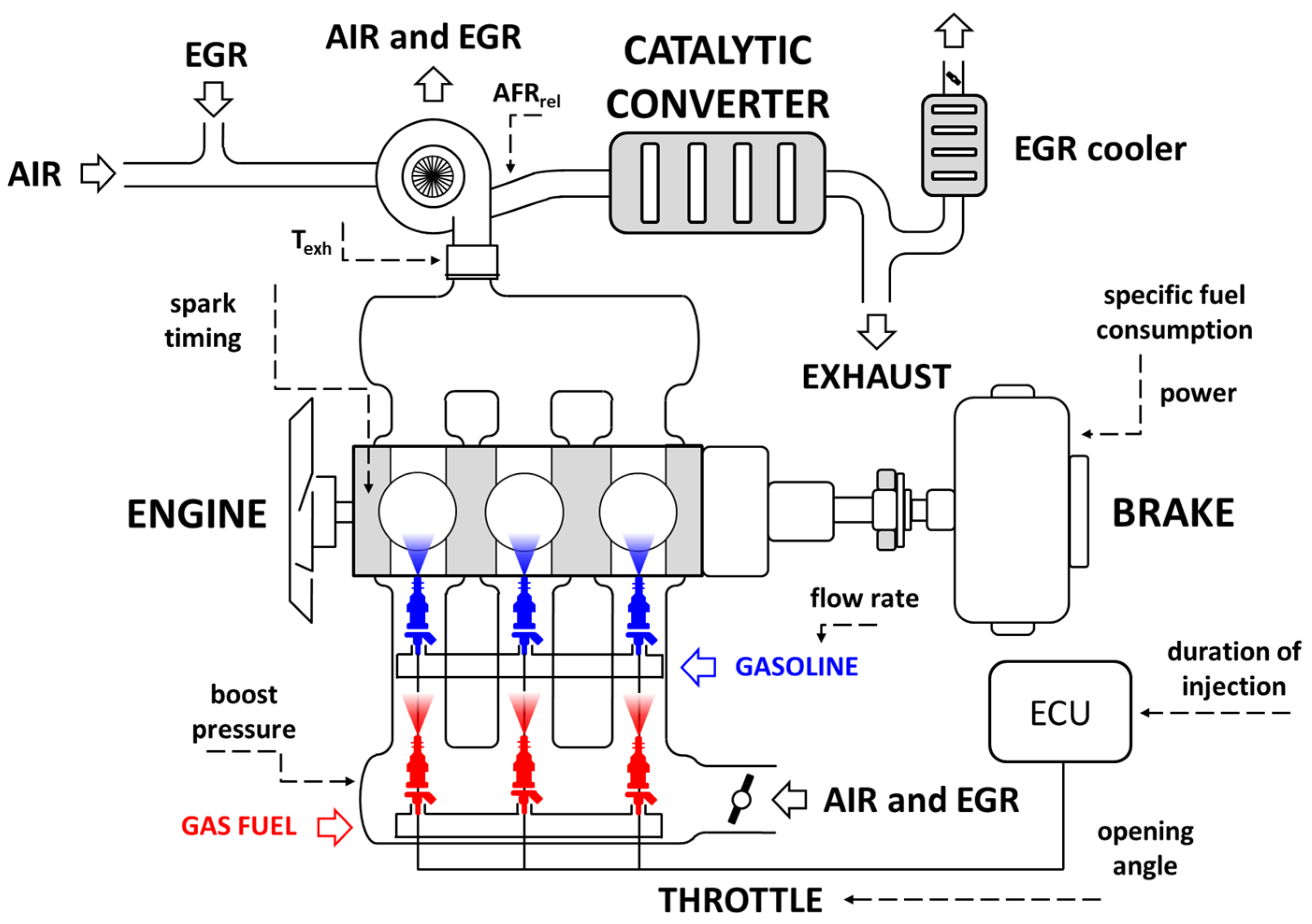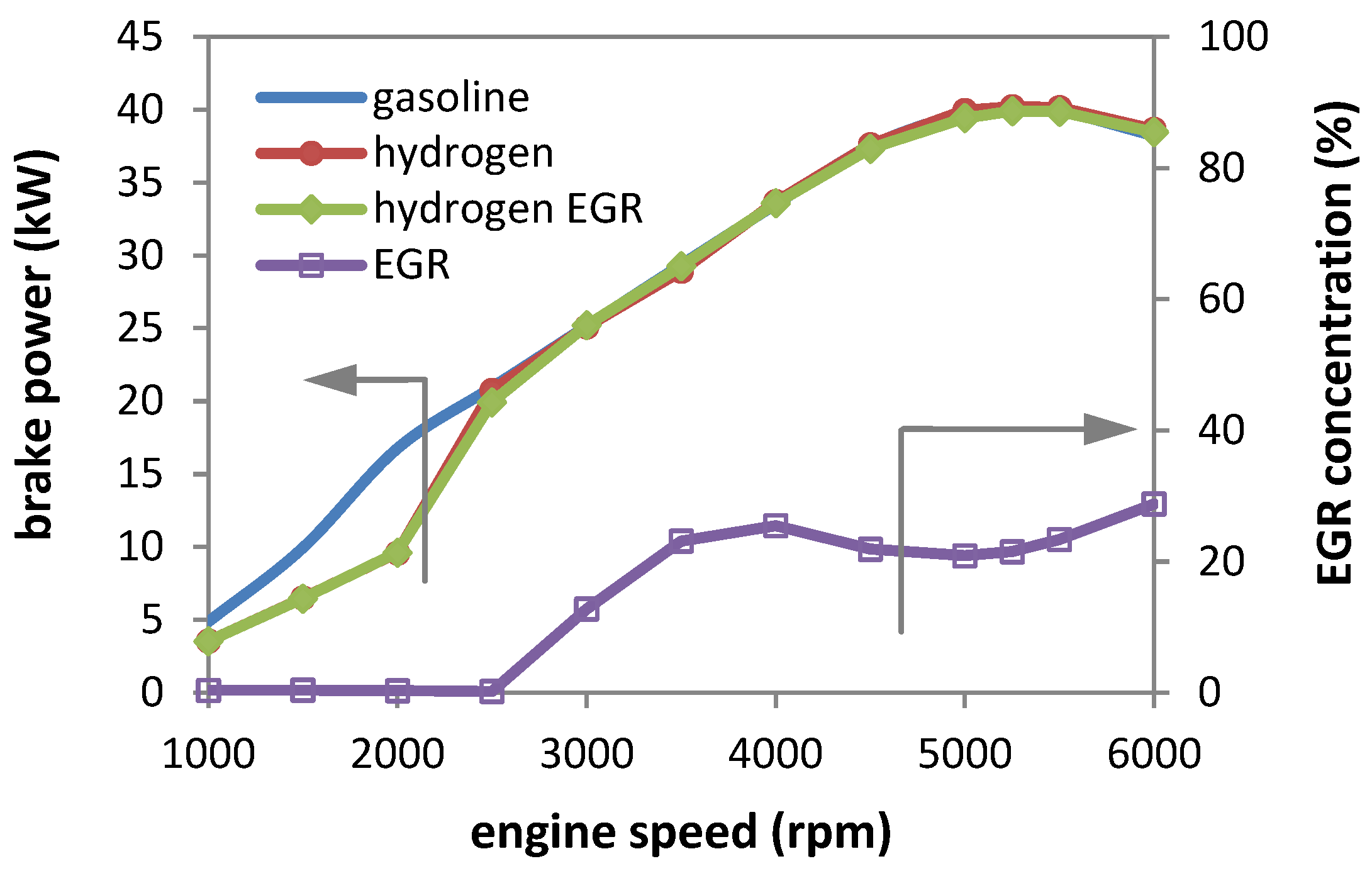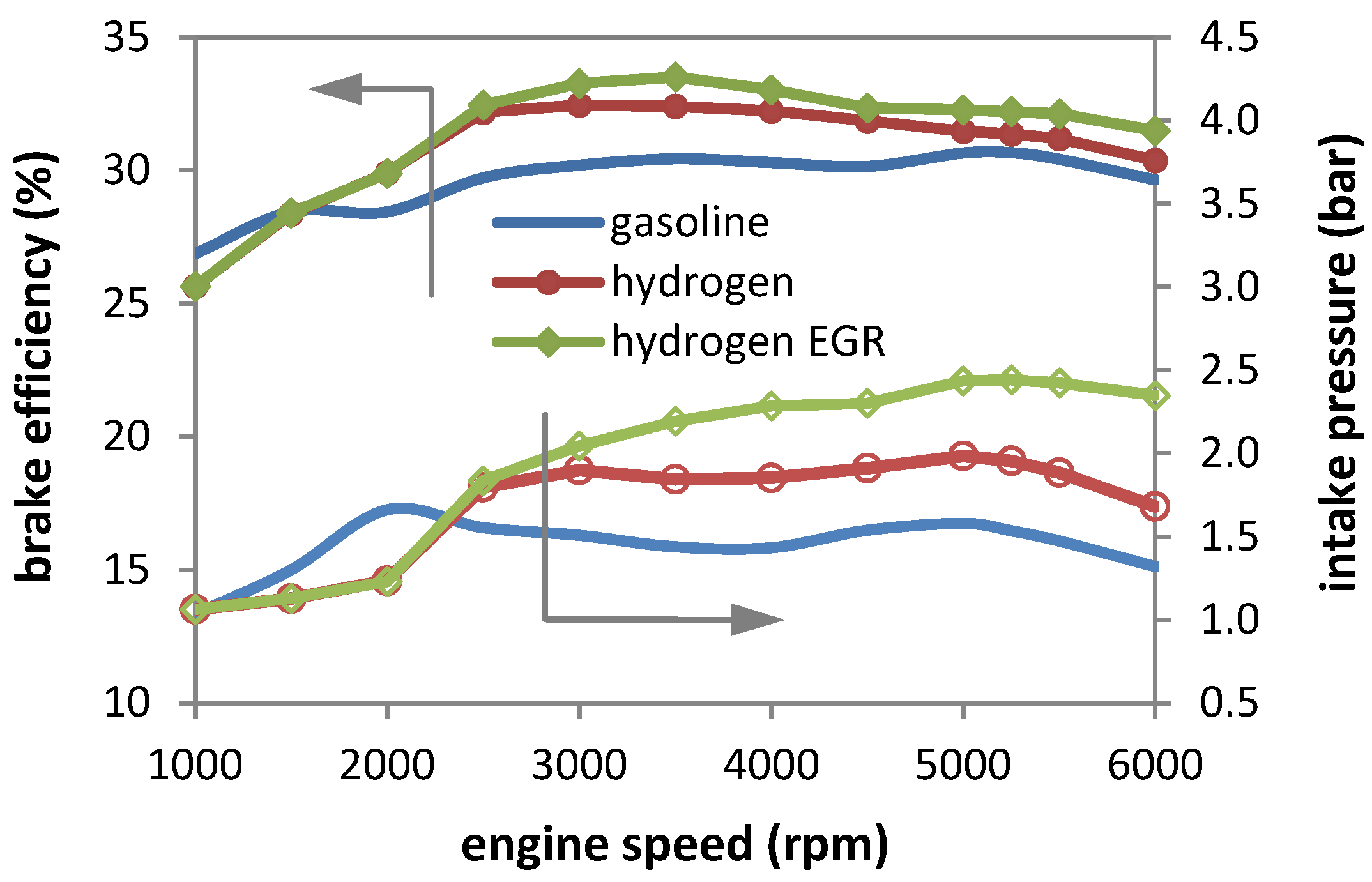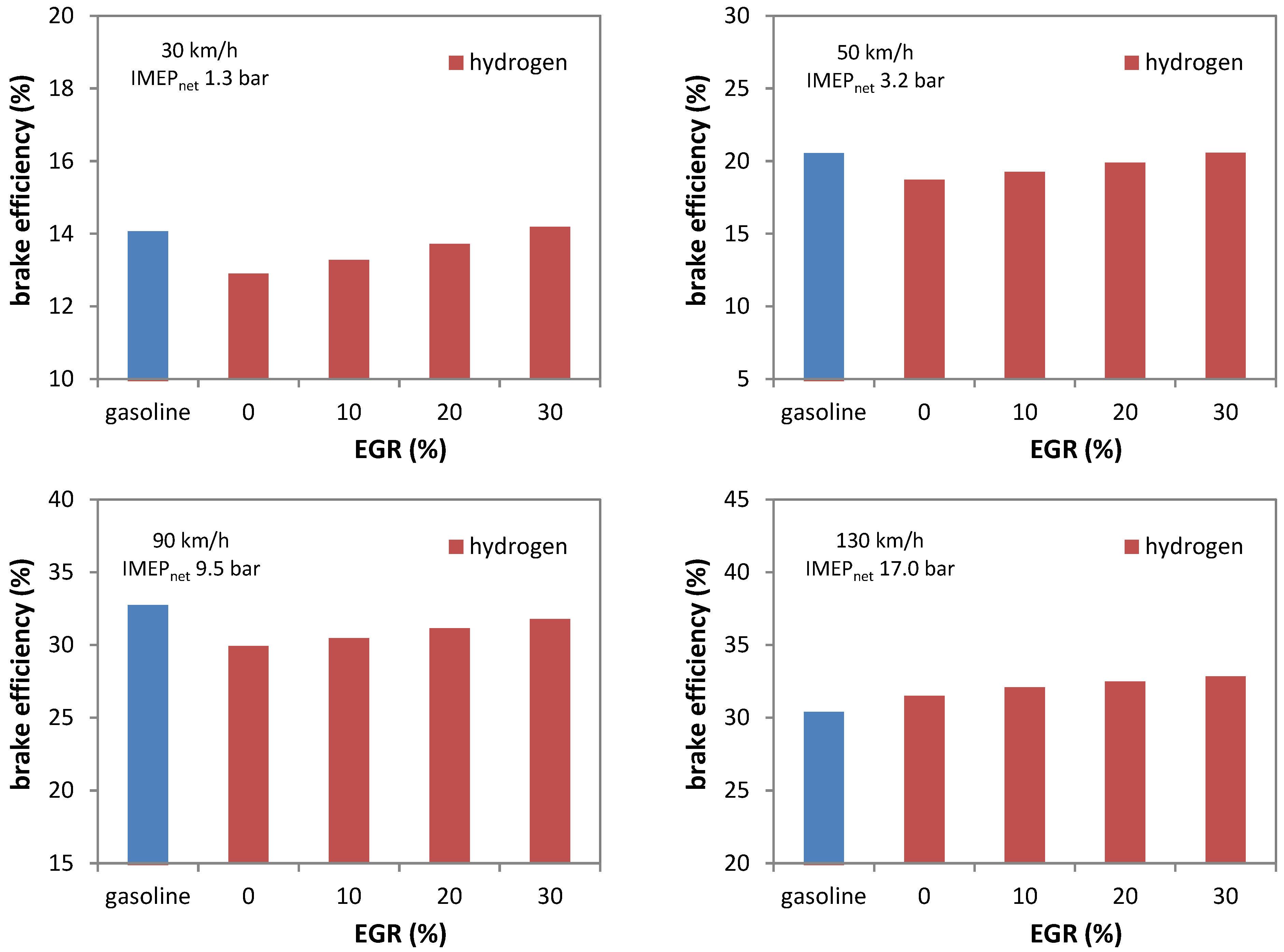Conversion of a Small-Size Passenger Car to Hydrogen Fueling: 0D/1D Simulation of EGR and Related Flow Limitations
Abstract
:1. Introduction
2. Materials and Methods
3. Results and Discussion
4. Conclusions
- Full-load characteristics revealed that only the low-pressure recirculation configuration was favorable, as the high-pressure variant would move the compressor operating point close to the surge line even at peak power. Maximum recirculation levels were predicted to be close to 30%, but only at high rpm. Minor improvements in efficiency could be obtained with EGR, whereas the most consistent full-load relative gains of around 10% came from the fact that the engine was operated stoichiometrically compared to the AFRrel of 0.9 for gasoline. A major benefit was found in the form of contained maximum pressure rise rates, which were predicted to be below 10 bar/deg when using EGR and directly comparable to those calculated for the reference fuel.
- High heat losses were found to be a determining factor during urban driving. A positive aspect of EGR was that it could fully mitigate this negative effect at 30 and 50 km/h vehicle speed with recirculation rates of up to 30%; higher values would be required for the 90 km/h condition.
- Highway driving at 130 km/h was found to be a condition that further emphasizes the potential of EGR when using H2, with an increase in efficiency of close to 8% compared to the gasoline reference case.
Author Contributions
Funding
Data Availability Statement
Conflicts of Interest
Abbreviations
| 0D/1D | Zero-/one-dimensional |
| CFD | Computational fluid dynamics |
| DEM | Dilution exponent multiplier |
| ECU | Electronic control unit |
| EGR | Exhaust gas recirculation |
| GHG | Greenhouse gas |
| HCCI | Homogenous charge compression ignition |
| HP | High pressure |
| ICE | Internal combustion engine |
| LP | Low pressure |
| MFB | Mass fraction burned |
| OEM | Official equipment manufacturer |
| PFI | Port fuel injection |
| PID | Proportional integral derivative |
| PRR | Pressure rise rate |
| SI | Spark ignition |
| TDC | Top dead center, with a for after and b for before |
References
- Sacchi, R.; Bauer, C.; Cox, B.; Mutel, C. When, where and how can the electrification of passenger cars reduce greenhouse gas emissions? Renew. Sustain. Energy Rev. 2022, 162, 112475. [Google Scholar] [CrossRef]
- Le, T.T.; Sharma, P.; Bora, B.J.; Tran, V.D.; Truong, T.H.; Le, H.C.; Nguyen, P.Q.P. Fueling the future: A comprehensive review of hydrogen energy systems and their challenges. Int. J. Hydrog. Energ. 2024, 54, 791–816. [Google Scholar] [CrossRef]
- Rolo, I.; Costa, V.A.F.; Brito, F.P. Hydrogen-Based Energy Systems: Current Technology Development Status, Opportunities and Challenges. Energies 2024, 17, 180. [Google Scholar] [CrossRef]
- Mills, S.J. Heavy duty hydrogen ICE: Production realization by 2025 and system operation efficiency assessment. In Powertrain Systems for Net-Zero Transport, 1st ed.; CRC Press: Boca Raton, FL, USA, 2021; ISBN 9781003219217. [Google Scholar]
- Verhelst, S.; Wallner, T. Hydrogen-fueled internal combustion engines. Prog. Energ. Combust. Sci. 2009, 35, 490–527. [Google Scholar] [CrossRef]
- Molina, S.; Novella, R.; Gomez-Soriano, J.; Olcina-Girona, M. Experimental Activities on a Hydrogen-Fueled Spark-Ignition Engine for Light-Duty Applications. Appl. Sci. 2023, 13, 12055. [Google Scholar] [CrossRef]
- Kosmadakis, G.M.; Rakopoulos, D.C.; Rakopoulos, C.D. Assessing the cyclic-variability of spark-ignition engine running on methane-hydrogen blends with high hydrogen contents of up to 50%. Int. J. Hydrog. Energ. 2021, 46, 17955–17968. [Google Scholar] [CrossRef]
- Irimescu, A.; Cecere, G.; Sementa, P. Combustion Phasing Indicators for Optimized Spark Timing Settings for Methane-Hydrogen Powered Small Size Engines; SAE Technical Paper 2022-01-0603; SAE International: Warrendale, PA, USA, 2022. [Google Scholar] [CrossRef]
- Stępień, Z.A. Comprehensive Overview of Hydrogen-Fueled Internal Combustion Engines: Achievements and Future Challenges. Energies 2021, 14, 650. [Google Scholar] [CrossRef]
- Fischer, M.; Sterlepper, S.; Pischinger, S.; Seibel, J.; Kramer, U.; Lorenz, T. Operation principles for hydrogen spark ignited direct injection engines for passenger car applications. Int. J. Hydrog. Energ. 2021, 47, 5638–5649. [Google Scholar] [CrossRef]
- Gao, J.; Wang, X.; Song, P.; Tian, G.; Ma, C. Review of the backfire occurrences and control strategies for port hydrogen injection internal combustion engines. Fuel 2022, 307, 121553. [Google Scholar] [CrossRef]
- Yang, Z.; Zhang, F.; Wang, L.; Wang, K.; Zhang, D. Effects of injection mode on the mixture formation and combustion performance of the hydrogen internal combustion engine. Energy 2018, 147, 715–728. [Google Scholar] [CrossRef]
- Diéguez, P.M.; Urroz, J.C.; Sáinz, D.; Machin, J.; Arana, M.; Gandía, L.M. Characterization of combustion anomalies in a hydrogen-fueled 1.4 L commercial spark-ignition engine by means of in-cylinder pressure, block-engine vibration, and acoustic measurements. Energ. Convers. Manag. 2018, 172, 67–80. [Google Scholar] [CrossRef]
- Wallner, T.; Lohse-Busch, H.; Gurski, S.; Duoba, M.; Thiel, W.; Martin, D.; Korn, T. Fuel economy and emissions evaluation of BMW Hydrogen 7 Mono-Fuel demonstration vehicles. Int. J. Hydrog. Energ. 2008, 33, 7607–7618. [Google Scholar] [CrossRef]
- Verhelst, S.; Vancoillie, J.; Naganuma, K.; De Paepe, M.; Dierickx, J.; Huyghebaert, Y.; Wallner, T. Setting a best practice for determining the EGR rate in hydrogen internal combustion engines. Int. J. Hydrog. Energ. 2013, 38, 2490–2503. [Google Scholar] [CrossRef]
- Wang, S.; Zhai, Y.; Wang, Z.; Hou, R.; Zhang, T.; Ji, C. Comparison of air and EGR with different water fractions dilutions on the combustion of hydrogen-air mixtures. Fuel 2022, 324, 124686. [Google Scholar] [CrossRef]
- Kim, J.; Chun, K.M.; Song, S.; Baek, H.; Lee, S.W. The effects of hydrogen on the combustion, performance and emissions of a turbo gasoline direct-injection engine with exhaust gas recirculation. Int. J. Hydrog. Energ. 2017, 42, 25074–25087. [Google Scholar] [CrossRef]
- Yu, X.; Guo, Z.; He, L.; Dong, W.; Sun, P.; Du, Y.; Li, Z.; Yang, H.; Wang, S.; Wu, H. Experimental study on lean-burn characteristics of an SI engine with hydrogen/gasoline combined injection and EGR. Int. J. Hydrog. Energ. 2019, 44, 13988–13998. [Google Scholar] [CrossRef]
- Pukalskas, S.; Kriaučiūnas, D.; Rimkus, A.; Przybyła, G.; Droździel, P.; Barta, D. Effect of Hydrogen Addition on the Energetic and Ecologic Parameters of an SI Engine Fueled by Biogas. Appl. Sci. 2021, 11, 742. [Google Scholar] [CrossRef]
- Bao, L.; Sun, B.; Luo, Q. Optimal control strategy of the turbocharged direct-injection hydrogen engine to achieve near-zero emissions with large power and high brake thermal efficiency. Fuel 2022, 325, 124913. [Google Scholar] [CrossRef]
- Zhu, H.; Duan, J. Research on emission characteristics of hydrogen fuel internal combustion engine based on more detailed mechanism. Int. J. Hydrog. Energ. 2019, 44, 5592–5598. [Google Scholar] [CrossRef]
- Novella, R.; García, A.; Gomez-Soriano, J.; Fogué-Robles, A. Exploring dilution potential for full load operation of medium duty hydrogen engine for the transport sector. Appl. Energ. 2023, 349, 121635. [Google Scholar] [CrossRef]
- Sterlepper, S.; Fischer, M.; Claßen, J.; Huth, V.; Pischinger, S. Concepts for Hydrogen Internal Combustion Engines and Their Implications on the Exhaust Gas Aftertreatment System. Energies 2021, 14, 8166. [Google Scholar] [CrossRef]
- Guo, H.; Zhou, S.; Zou, J.; Shreka, M. A Numerical Investigation on De-NOx Technology and Abnormal Combustion Control for a Hydrogen Engine with EGR System. Processes 2020, 8, 1178. [Google Scholar] [CrossRef]
- Dhyani, V.; Subramanian, K.A. Control of backfire and NOx emission reduction in a hydrogen fueled multi-cylinder spark ignition engine using cooled EGR and water injection strategies. Int. J. Hydrog. Energ. 2019, 44, 6287–6298. [Google Scholar] [CrossRef]
- Meng, H.; Ji, C.; Shen, J.; Yang, J.; Xin, G.; Chang, K.; Wang, S. Analyzing the effects of cooled EGR on the knock of hydrogen-fueled Wankel rotary engine. Int. J. Hydrog. Energ. 2022, 47, 33094–33104. [Google Scholar] [CrossRef]
- Meng, H.; Ji, C.; Shen, J.; Yang, J.; Xin, G.; Chang, K.; Wang, S. Analysis of combustion characteristics under cooled EGR in the hydrogen-fueled Wankel rotary engine. Energy 2023, 263, 125815. [Google Scholar] [CrossRef]
- Irimescu, A.; Vaglieco, B.M.; Merola, S.S.; Zollo, V.; De Marinis, R. Conversion of a Small Size Passenger Car to Hydrogen Fueling: Focus on Rated Power and Injection Phasing Effects; SAE Technical Paper 2022-24-0031; SAE International: Warrendale, PA, USA, 2022. [Google Scholar] [CrossRef]
- Smart EQ ForTwo. Available online: www.smart.mercedes-benz.com (accessed on 15 August 2022).
- Irimescu, A.; Vaglieco, B.M.; Merola, S.S.; Zollo, V.; De Marinis, R. Conversion of a Small-Size Passenger Car to Hydrogen Fueling: Simulation of CCV and Evaluation of Cylinder Imbalance. Machines 2023, 11, 135. [Google Scholar] [CrossRef]
- Gamma Technologies. GT-SUITE Flow Theory Manual, Version 7.4; Gamma Technologies: Westmont, IL, USA, 2013. [Google Scholar]
- Cuturi, N.; Sciubba, E. Design of a Tandem Compressor for the Electrically-Driven Turbocharger of a Hybrid City Car. Energies 2021, 14, 2890. [Google Scholar] [CrossRef]
- Gerke, U.; Steurs, K.; Rebecchi, P.; Boulouchos, K. Derivation of burning velocities of premixed hydrogen/air flames at engine-relevant conditions using a single-cylinder compression machine with optical access. Int. J. Hydrog. Energ. 2010, 35, 2566–2577. [Google Scholar] [CrossRef]
- Rakopoulos, C.D.; Kosmadakis, G.M.; Demuynck, J.; De Paepe, M.; Verhelst, S. A combined experimental and numerical study of thermal processes, performance and nitric oxide emissions in a hydrogen-fueled spark-ignition engine. Int. J. Hydrog. Energ. 2011, 36, 5163–5180. [Google Scholar] [CrossRef]
- Verhelst, S.; Woolley, R.; Lawes, M.; Sierens, R. Laminar and Unstable Burning Velocities and Markstein Lengths of Hydro-gen-Air Mixtures at Engine-Like Conditions. Proc. Combust. Inst. 2005, 30, 209–216. [Google Scholar] [CrossRef]
- Kosmadakis, G.M.; Rakopoulos, C.D.; Demuynck, J.; De Paepe, M.; Verhelst, S. CFD modeling and experimental study of combustion and nitric oxide emissions in hydrogen-fueled spark-ignition engine operating in a very wide range of EGR rates. Int. J. Hydrog. Energ. 2012, 37, 10917–10934. [Google Scholar] [CrossRef]
- Hunicz, J.; Mikulski, M.; Geca, M.S.; Rybak, A. An applicable approach to mitigate pressure rise rate in an HCCI engine with negative valve overlap. Appl. Energ. 2019, 257, 114018. [Google Scholar] [CrossRef]
- Heywood, J.B. Internal Combustion Engine Fundamentals; McGraw Hill: New York, NY, USA, 1988; ISBN 9780070286375. [Google Scholar]
- Demuynck, J.; De Paepe, M.; Huisseune, H.; Sierens, R.; Vancoillie, J.; Verhelst, S. On the applicability of empirical heat transfer models for hydrogen combustion engines. Int. J. Hydrog. Energ. 2011, 36, 975–984. [Google Scholar] [CrossRef]







| Displacement | 599 cm3 |
| Number of cylinders | 3 |
| Rated power | 40 kW @ 5250 rpm |
| Rated torque | 80 Nm @ 2000–4400 rpm |
| Bore × Stroke | 63.5 mm × 63.0 mm |
| Connecting rod length | 114 mm |
| Compression ratio | 9.5:1 |
| Number of valves | 2 per cylinder |
| Intake valve opening/closure | 363/164 deg bTDC |
| Exhaust valve opening/closure | 157/349 deg a/bTDC |
| Fuel system | Port fuel injection at 3.5 bar for gasoline and 5 bar for gas H2 |
| Ignition | Inductive discharge, 2 spark plugs per cylinder |
Disclaimer/Publisher’s Note: The statements, opinions and data contained in all publications are solely those of the individual author(s) and contributor(s) and not of MDPI and/or the editor(s). MDPI and/or the editor(s) disclaim responsibility for any injury to people or property resulting from any ideas, methods, instructions or products referred to in the content. |
© 2024 by the authors. Licensee MDPI, Basel, Switzerland. This article is an open access article distributed under the terms and conditions of the Creative Commons Attribution (CC BY) license (https://creativecommons.org/licenses/by/4.0/).
Share and Cite
Irimescu, A.; Vaglieco, B.M.; Merola, S.S.; Zollo, V.; De Marinis, R. Conversion of a Small-Size Passenger Car to Hydrogen Fueling: 0D/1D Simulation of EGR and Related Flow Limitations. Appl. Sci. 2024, 14, 844. https://doi.org/10.3390/app14020844
Irimescu A, Vaglieco BM, Merola SS, Zollo V, De Marinis R. Conversion of a Small-Size Passenger Car to Hydrogen Fueling: 0D/1D Simulation of EGR and Related Flow Limitations. Applied Sciences. 2024; 14(2):844. https://doi.org/10.3390/app14020844
Chicago/Turabian StyleIrimescu, Adrian, Bianca Maria Vaglieco, Simona Silvia Merola, Vasco Zollo, and Raffaele De Marinis. 2024. "Conversion of a Small-Size Passenger Car to Hydrogen Fueling: 0D/1D Simulation of EGR and Related Flow Limitations" Applied Sciences 14, no. 2: 844. https://doi.org/10.3390/app14020844





